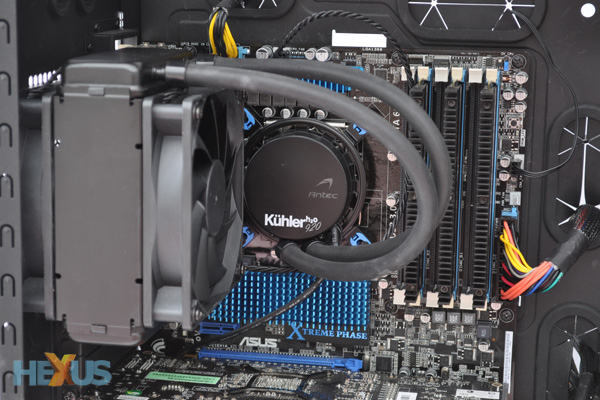Test methodology

To put the performance of the KÜHLER H2O 920 into perspective, we're testing the unit in a high-end Intel Core i7 system and comparing benchmark results with a range of alternative air- and liquid-coolers. A detailed description of our test system and all six comparison coolers can be found in the tables below.
Test Bench |
||||||
|---|---|---|---|---|---|---|
| Processor | Intel Core i7 980X (3.33GHz, 12MB L3 cache, hexa-core) | |||||
| Motherboard | ASUS P6X58D Premium | |||||
| Memory | Corsair Dominator 6GB (3 x 2GB) DDR3 @ 1,600MHz | |||||
| Graphics | AMD Radeon HD 5850 1GB | |||||
| Disk drive | 120GB SSD | |||||
| Optical drive | Generic 24x DVD-RW | |||||
| Chassis | Corsair Obsidian Series 800D | |||||
| Power supply | Corsair HX1000W | |||||
| Operating system | Windows 7 Ultimate 64-bit | |||||
Comparison Coolers |
|||||||
|---|---|---|---|---|---|---|---|
| Cooler | Antec KÜHLER H2O 920 | Corsair Hydro Series H70 | Corsair Hydro Series H60 | Corsair Hydro Series H50 | Noctua NH-D14 | Prolimatech Megahalems Rev B | Intel DBX-B |
| Cooler type | Liquid | Liquid | Liquid | Liquid | Air | Air | Air |
| Fan(s) | 2x Antec 120mm | 2x Corsair 120mm | Corsair 120mm | Corsair 120mm | Noctua NF-P14 & Noctua NF-P12 | 2x Akasa Apache Black 120mm | Intel 100mm |
| Maximum fan speed | 2,400RPM | 2,000 RPM | 1,700 RPM | 1,700 RPM | 1,300 RPM | 1,300 RPM | 1,800 RPM |
| Radiator dimensions | Width: 120mm Height: 151mm Depth: 49mm |
Width: 120mm Height: 152mm Depth: 48mm |
Width: 120mm Height: 152mm Depth: 27mm |
Width: 120mm Height: 152mm Depth: 27mm |
- | - | - |
| Pump / Heatsink dimensions (inc. fans) |
Height: 29mm Diameter: 74mm |
Height: 30mm Diameter: 74mm |
Height: 30mm Width: 66mm Depth: 66mm |
Height: 55mm Diameter: 70mm |
Height: 160mm Width: 140mm Depth: 158mm |
Height: 159mm Width: 130mm Depth: 124mm |
Height: 140mm Width: 100mm Depth: 70mm |
| Approx. price (inc. fans) | £80 | £75 | £60 | £50 | £65 | £65 | N/A |
Benchmark Process
To get a feel for how well all of the above coolers compare, we start by running the Core i7 980X at its default frequency and record the temperature each minute for 30 minutes whilst the system idles. We then repeat the process with the system under load (defined as Prime95 tasking all 12 threads).
We then do it all over again, only this time with the Core i7 980X processor overclocked to 4.15GHz and CPU voltage increased from 1.2V to 1.35V.
Temperature for each of the CPU's six cores is logged every minute, and in order to provide stabilised readings, we then calculate an average across all cores from the last 10 minutes of testing.
Actual CPU temperature is recorded, but to take into account any temperature fluctuations in our lab, we also graph the delta temperature - that's CPU temperature minus ambient temperature.
Finally, we overclock the Core i7 980X chip a further few notches to see how the cooler copes in extreme scenarios, and we use a PCE-318 noise level meter to provide an assessment on noise.
Notes
During testing, our Corsair Obsidian Series 800D chassis is equipped with its default fan configuration; a 140mm drive-bay fan, a 140mm lower compartment fan and a 140mm rear exhaust. The rear exhaust is removed and replaced by the radiator/fan when testing the liquid coolers.
To get an idea of how the KÜHLER H2O 920's fan modes vary, we test the cooler in both its Extreme and Silent modes. All other coolers are configured for optimum cooling performance, but users should note that Noctua's gargantuan NH-D14 is simply too big to implement horizontally in our Obsidian Series 800D chassis and had to be used with its fans facing upward. As a result, one of its two fans is in close proximity to the GPU and with no top exhaust in our chassis, it delivers sub-optimal results.









